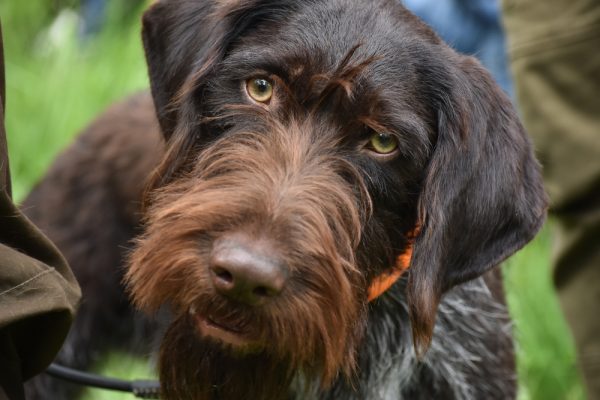
The Barbet is credited with being an ancestor of the Poodle, Bichon, Griffon, Otterhound, Newfoundland, Briard, and “several others,” and among those “several others” is the German Wirehaired Pointer. But we get ahead of ourselves.
The Barbet was one of Europe’s first rough-haired sporting dogs, said by some to be developed from crosses between the Schapudel (or Schafspudel, an old German herding dog) and Bracke, smooth coated hunting dogs. When the Barbet was crossed in the 19th century with other German Sporting breeds, the Ruehaair, or Stichelhaar (as it’s better known today) was born. But the Germans weren’t done yet.
When the political landscape changed in Germany in the 19th century, it opened up the sport of hunting to people who’d been previously shut out by laws favoring aristocracy and the privileged. Still, not everyone could afford to have kennels filled with canine “specialists.” Most people needed one dog that could not only find game, hunt, trail, point, and retrieve, but one dog that could do it on varied terrain and water. As long as they were working out their wish list, the dog should also be able to hunt birds and land creatures, have a good nose, be fast, have stamina, and point.
Remember the Stichelhaair we mentioned earlier? Well, the Germans remembered it too, especially its rough coat. In developing that one dog, they also introduced German Pudels for their heavy boned sturdiness, and Pointers for their fine retrieving skills. What they got was a pretty fabulous breed we know today as the Pudelpointer.
The Pudelpointer was crossed with German Shorthair Pointers, the Griffon, Foxhound, and the Polish Water Dog to give us today’s GWP.
We should mention that the German Wirehaired Pointer is sometimes referred to as Drahthaar. Some breed historians say that these dogs came to American with German immigrants and American servicemen returning to the U.S. with their new companions. Another source we came across insists that the German Wirehair Pointer was the result of the Deutsch-Drahthaar being imported to the U.S. after WWII by people who sought registration within the AKC. Once recognized by that registry, the German Wirehair was shaped into a “specialist” which is why the word, “pointer” was added to its name. Not everyone agrees with that view, but others felt that the “Deutsch Drahthaar” and “German Wirehair” were no longer synonymous, and point out that two organizations emerged in the 1970s, each taking the breed in a different direction (they were the German Wirehaired Pointer Club of America and the Verein Deutsch Drahthaar Group North America. We always defer to breed experts and would like to hear from GWP folks to verify or dispute this.
All that said, the GWP is not a German Shorthaired Pointer with different hair. The two breeds were developed separately (the Shorthair is slightly older), and there are significant differences. The Wirehaired has a slightly larger and sturdier build with a longer body, and its head is also shaped differently. The GWP’s brows should be well developed, while the GSP’s brows should be moderately developed. People who’ve hunted with both say that a Wirehairs’ point tends to be less angular and more solidly balanced, as if the dog is growing out of the ground. We read one article that opined that “if the German Shorthaired Pointer is the sports car of the dock-tail pointing breeds, then consider the German Wirehaired Pointer a muddy ranch pickup.”
Vivid, but point made.
Image: German Wirehaired Pointer by Morev Nikolay/Depositphotos
